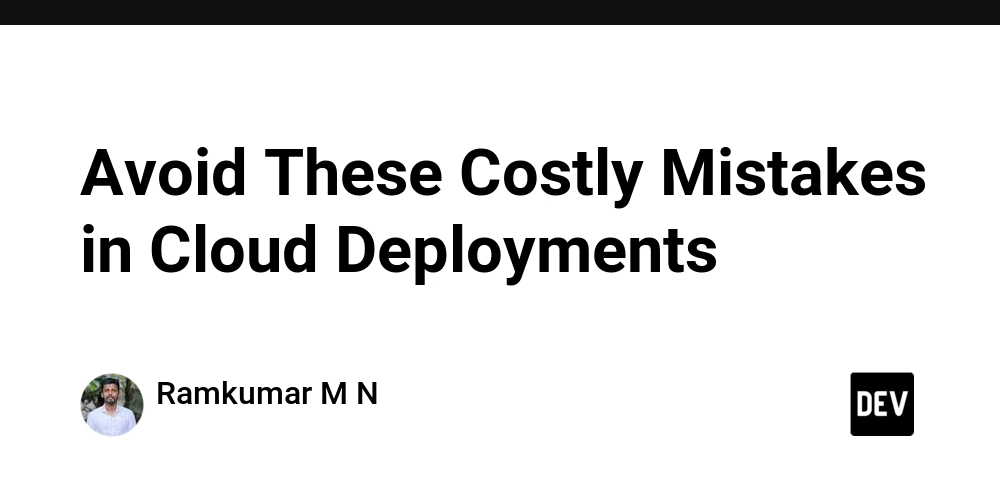Avoid These Costly Mistakes in Cloud Deployments
Deploying applications in the cloud can be complex, and small mistakes can lead to security risks, performance issues, or unexpected costs. Here are the most common cloud deployment mistakes and how to avoid them. 1. Ignoring Cost Optimization Many teams forget to optimize their cloud costs, leading to unnecessary expenses. ❌ Mistake: Running unused instances Using on-demand instances for long-running workloads ✅ Solution: Use auto-scaling to adjust resources dynamically Switch to reserved or spot instances for cost savings Regularly review billing reports 2. Poor Security Configurations Misconfigured security settings can expose your infrastructure to attacks. ❌ Mistake: Leaving S3 buckets publicly accessible Using default security group settings (open to all traffic) Hardcoding credentials in the code ✅ Solution: Enable IAM roles and least privilege access Restrict S3 bucket permissions Use AWS Secrets Manager or Azure Key Vault for credentials 3. Not Using Load Balancers Failing to distribute traffic can lead to downtime and poor performance. ❌ Mistake: Running everything on a single instance No redundancy for high-traffic applications ✅ Solution: Use AWS ELB or Azure Load Balancer for distributing requests Implement horizontal scaling instead of relying on a single powerful instance 4. Ignoring Logging and Monitoring Without proper logging, troubleshooting production issues becomes difficult. ❌ Mistake: Not collecting logs from cloud services Ignoring performance metrics ✅ Solution: Use AWS CloudWatch, Azure Monitor, or GCP Stackdriver for real-time monitoring Set up alerts for anomalies and automate incident response 5. Overlooking Data Backup and Disaster Recovery Cloud failures can happen. If you don’t have backups, you risk losing critical data. ❌ Mistake: No backup strategy Storing backups in the same region as the main data ✅ Solution: Enable automated backups in AWS RDS, Azure SQL, or GCP Cloud SQL Use multi-region storage for disaster recovery 6. Choosing the Wrong Instance Type Using the wrong compute instance leads to performance bottlenecks or wasted resources. ❌ Mistake: Using general-purpose instances for compute-heavy workloads Running memory-intensive applications on low-RAM instances ✅ Solution: Choose compute-optimized instances for CPU-heavy tasks Use memory-optimized instances for databases and caching 7. Hardcoding Environment Variables Storing environment-specific configurations directly in the code is risky. ❌ Mistake: DB_PASSWORD = "mysecretpassword" ✅ Solution: Use environment variables (.env files) Store secrets in AWS Parameter Store, Azure Key Vault, or GCP Secret Manager 8. Not Implementing Auto-Scaling Applications should scale up and down automatically based on demand. ❌ Mistake: Running fixed-size clusters Manually adjusting server capacity ✅ Solution: Use AWS Auto Scaling, Azure Scale Sets, or GCP Autoscaler Configure threshold-based scaling policies 9. Deploying Without CI/CD Pipelines Manually deploying code increases the risk of errors and inconsistencies. ❌ Mistake: Manually updating production servers No version control for deployment configurations ✅ Solution: Set up CI/CD pipelines using GitHub Actions, Jenkins, or GitLab CI/CD Use Infrastructure as Code (IaC) with Terraform or CloudFormation 10. Not Testing Infrastructure Changes Deploying infrastructure changes without testing can break production environments. ❌ Mistake: Directly applying Terraform or Kubernetes changes in production No rollback plan for failed deployments ✅ Solution: Use staging environments to test changes Implement blue-green deployments or canary releases Final Thoughts Cloud deployments can be challenging, but avoiding these mistakes will save you time, money, and headaches. What other cloud deployment lessons have you learned? Share them in the comments!

Deploying applications in the cloud can be complex, and small mistakes can lead to security risks, performance issues, or unexpected costs. Here are the most common cloud deployment mistakes and how to avoid them.
1. Ignoring Cost Optimization
Many teams forget to optimize their cloud costs, leading to unnecessary expenses.
❌ Mistake:
- Running unused instances
- Using on-demand instances for long-running workloads
✅ Solution:
- Use auto-scaling to adjust resources dynamically
- Switch to reserved or spot instances for cost savings
- Regularly review billing reports
2. Poor Security Configurations
Misconfigured security settings can expose your infrastructure to attacks.
❌ Mistake:
- Leaving S3 buckets publicly accessible
- Using default security group settings (open to all traffic)
- Hardcoding credentials in the code
✅ Solution:
- Enable IAM roles and least privilege access
- Restrict S3 bucket permissions
- Use AWS Secrets Manager or Azure Key Vault for credentials
3. Not Using Load Balancers
Failing to distribute traffic can lead to downtime and poor performance.
❌ Mistake:
- Running everything on a single instance
- No redundancy for high-traffic applications
✅ Solution:
- Use AWS ELB or Azure Load Balancer for distributing requests
- Implement horizontal scaling instead of relying on a single powerful instance
4. Ignoring Logging and Monitoring
Without proper logging, troubleshooting production issues becomes difficult.
❌ Mistake:
- Not collecting logs from cloud services
- Ignoring performance metrics
✅ Solution:
- Use AWS CloudWatch, Azure Monitor, or GCP Stackdriver for real-time monitoring
- Set up alerts for anomalies and automate incident response
5. Overlooking Data Backup and Disaster Recovery
Cloud failures can happen. If you don’t have backups, you risk losing critical data.
❌ Mistake:
- No backup strategy
- Storing backups in the same region as the main data
✅ Solution:
- Enable automated backups in AWS RDS, Azure SQL, or GCP Cloud SQL
- Use multi-region storage for disaster recovery
6. Choosing the Wrong Instance Type
Using the wrong compute instance leads to performance bottlenecks or wasted resources.
❌ Mistake:
- Using general-purpose instances for compute-heavy workloads
- Running memory-intensive applications on low-RAM instances
✅ Solution:
- Choose compute-optimized instances for CPU-heavy tasks
- Use memory-optimized instances for databases and caching
7. Hardcoding Environment Variables
Storing environment-specific configurations directly in the code is risky.
❌ Mistake:
DB_PASSWORD = "mysecretpassword"
✅ Solution:
- Use environment variables (
.envfiles) - Store secrets in AWS Parameter Store, Azure Key Vault, or GCP Secret Manager
8. Not Implementing Auto-Scaling
Applications should scale up and down automatically based on demand.
❌ Mistake:
- Running fixed-size clusters
- Manually adjusting server capacity
✅ Solution:
- Use AWS Auto Scaling, Azure Scale Sets, or GCP Autoscaler
- Configure threshold-based scaling policies
9. Deploying Without CI/CD Pipelines
Manually deploying code increases the risk of errors and inconsistencies.
❌ Mistake:
- Manually updating production servers
- No version control for deployment configurations
✅ Solution:
- Set up CI/CD pipelines using GitHub Actions, Jenkins, or GitLab CI/CD
- Use Infrastructure as Code (IaC) with Terraform or CloudFormation
10. Not Testing Infrastructure Changes
Deploying infrastructure changes without testing can break production environments.
❌ Mistake:
- Directly applying Terraform or Kubernetes changes in production
- No rollback plan for failed deployments
✅ Solution:
- Use staging environments to test changes
- Implement blue-green deployments or canary releases
Final Thoughts
Cloud deployments can be challenging, but avoiding these mistakes will save you time, money, and headaches. What other cloud deployment lessons have you learned? Share them in the comments!










































































































































































![[The AI Show Episode 144]: ChatGPT’s New Memory, Shopify CEO’s Leaked “AI First” Memo, Google Cloud Next Releases, o3 and o4-mini Coming Soon & Llama 4’s Rocky Launch](https://www.marketingaiinstitute.com/hubfs/ep%20144%20cover.png)


























































































































































![BPMN-procesmodellering [closed]](https://i.sstatic.net/l7l8q49F.png)


























































































-All-will-be-revealed-00-35-05.png?width=1920&height=1920&fit=bounds&quality=70&format=jpg&auto=webp#)
-All-will-be-revealed-00-17-36.png?width=1920&height=1920&fit=bounds&quality=70&format=jpg&auto=webp#)






















































































































![What iPhone 17 model are you most excited to see? [Poll]](https://9to5mac.com/wp-content/uploads/sites/6/2025/04/iphone-17-pro-sky-blue.jpg?quality=82&strip=all&w=290&h=145&crop=1)
















![Hands-On With 'iPhone 17 Air' Dummy Reveals 'Scary Thin' Design [Video]](https://www.iclarified.com/images/news/97100/97100/97100-640.jpg)
![Mike Rockwell is Overhauling Siri's Leadership Team [Report]](https://www.iclarified.com/images/news/97096/97096/97096-640.jpg)
![Instagram Releases 'Edits' Video Creation App [Download]](https://www.iclarified.com/images/news/97097/97097/97097-640.jpg)
![Inside Netflix's Rebuild of the Amsterdam Apple Store for 'iHostage' [Video]](https://www.iclarified.com/images/news/97095/97095/97095-640.jpg)






























































































































